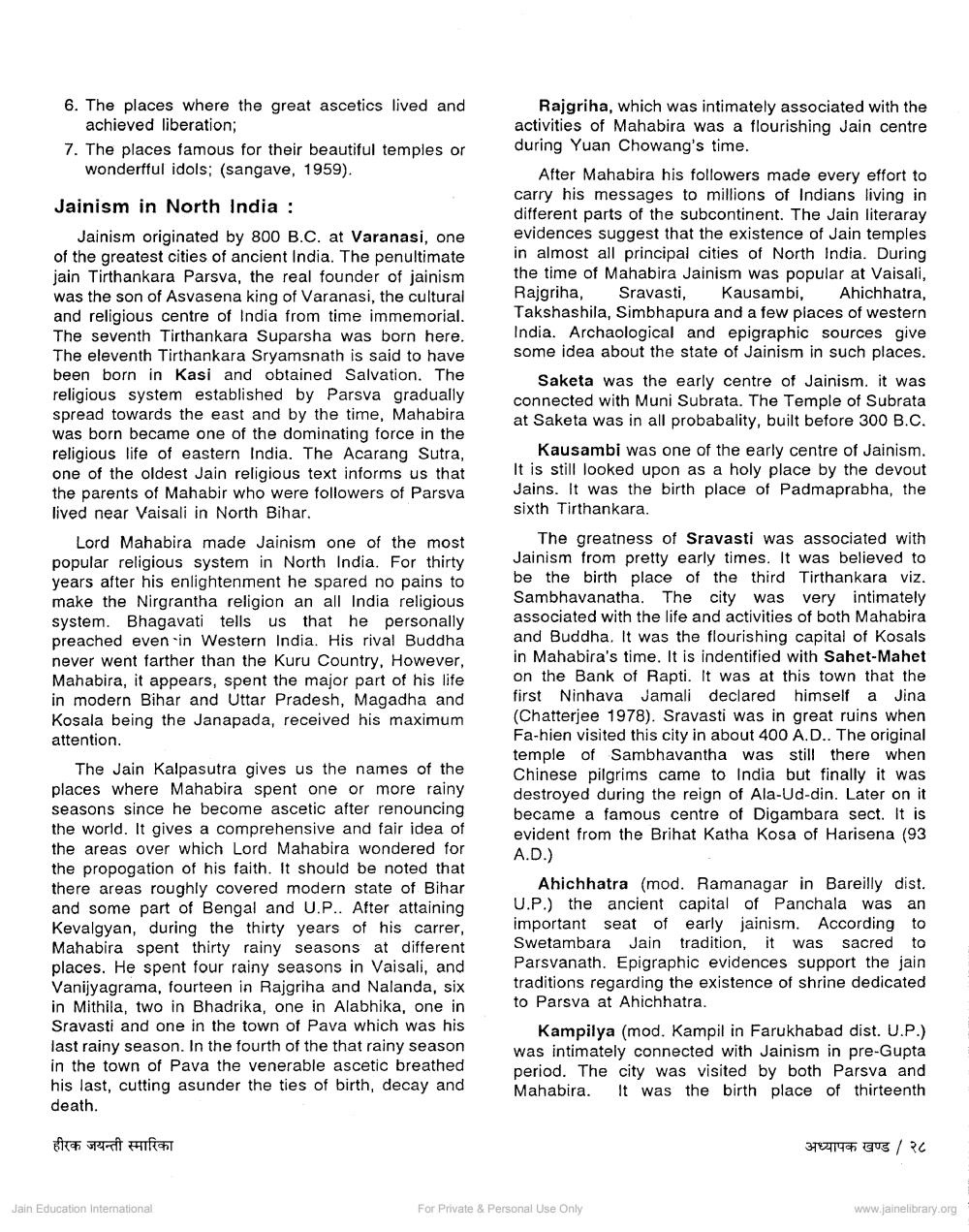________________ 6. The places where the great ascetics lived and achieved liberation; 7. The places famous for their beautiful temples or wonderfful idols; (sangave, 1959). Rajgriha, which was intimately associated with the activities of Mahabira was a flourishing Jain centre during Yuan Chowang's time. After Mahabira his followers made every effort to carry his messages to millions of Indians living in different parts of the subcontinent. The Jain literaray evidences suggest that the existence of Jain temples in almost all principal cities of North India. During the time of Mahabira Jainism was popular at Vaisali, Rajgriha, Sravasti, Kausambi, Ahichhatra, Takshashila, Simbhapura and a few places of Western India. Archaological and epigraphic sources give some idea about the state of Jainism in such places. Saketa was the early centre of Jainism. it was connected with Muni Subrata. The Temple of Subrata at Saketa was in all probabality, built before 300 B.C. Kausambi was one of the early centre of Jainism. It is still looked upon as a holy place by the devout Jains. It was the birth place of Padmaprabha, the sixth Tirthankara. Jainism in North India : Jainism originated by 800 B.C. at Varanasi, one of the greatest cities of ancient India. The penultimate jain Tirthankara Parsva, the real founder of jainism was the son of Asvasena king of Varanasi, the cultural and religious centre of India from time immemorial. The seventh Tirthankara Suparsha was born here. The eleventh Tirthankara Sryamsnath is said to have been born in Kasi and obtained Salvation. The religious system established by Parsva gradually spread towards the east and by the time, Mahabira was born became one of the dominating force in the religious life of eastern India. The Acarang Sutra, one of the oldest Jain religious text informs us that the parents of Mahabir who were followers of Parsva lived near Vaisali in North Bihar. Lord Mahabira made Jainism one of the most popular religious system in North India. For thirty years after his enlightenment he spared no pains to make the Nirgrantha religion an all India religious system. Bhagavati tells us that he personally preached even in Western India. His rival Buddha never went farther than the Kuru Country, However, Mahabira, it appears, spent the major part of his life in modern Bihar and Uttar Pradesh, Magadha and Kosala being the Janapada, received his maximum attention. The Jain Kalpasutra gives us the names of the places where Mahabira spent one or more rainy seasons since he become ascetic after renouncing the world. It gives a comprehensive and fair idea of the areas over which Lord Mahabira wondered for the propogation of his faith. It should be noted that there areas roughly covered modern state of Bihar and some part of Bengal and U.P.. After attaining Kevalgyan, during the thirty years of his carrer, Mahabira spent thirty rainy seasons at different places. He spent four rainy seasons in Vaisali, and Vaniyagrama, fourteen in Rajgriha and Nalanda, six in Mithila, two in Bhadrika, one in Alabhika, one in Sravasti and one in the town of Pava which was his last rainy season. In the fourth of the that rainy season in the town of Pava the venerable ascetic breathed his last, cutting asunder the ties of birth, decay and death. The greatness of Sravasti was associated with Jainism from pretty early times. It was believed to be the birth place of the third Tirthankara viz. Sambhavanatha. The city was very intimately associated with the life and activities of both Mahabira and Buddha. It was the flourishing capital of Kosals in Mahabira's time. It is indentified with Sahet-Mahet on the Bank of Rapti. It was at this town that the first Ninhava Jamali declared himself a Jina (Chatterjee 1978). Sravasti was in great ruins when Fa-hien visited this city in about 400 A.D.. The original temple of Sambhavantha was still there when Chinese pilgrims came to India but finally it was destroyed during the reign of Ala-Ud-din. Later on it became a famous centre of Digambara sect. It is evident from the Brihat Katha Kosa of Harisena (93 A.D.) Ahichhatra (mod. Ramanagar in Bareilly dist. U.P.) the ancient capital of Panchala was an important seat of early jainism. According to Swetambara Jain tradition, it was sacred to Parsvanath. Epigraphic evidences support the jain traditions regarding the existence of shrine dedicated to Parsva at Ahichhatra. Kampilya (mod. Kampil in Farukhabad dist. U.P.) was intimately connected with Jainism in pre-Gupta period. The city was visited by both Parsva and Mahabira. It was the birth place of thirteenth हीरक जयन्ती स्मारिका अध्यापक खण्ड / 28 Jain Education International For Private & Personal Use Only www.jainelibrary.org




